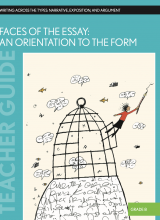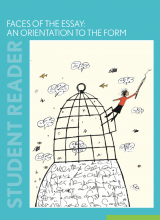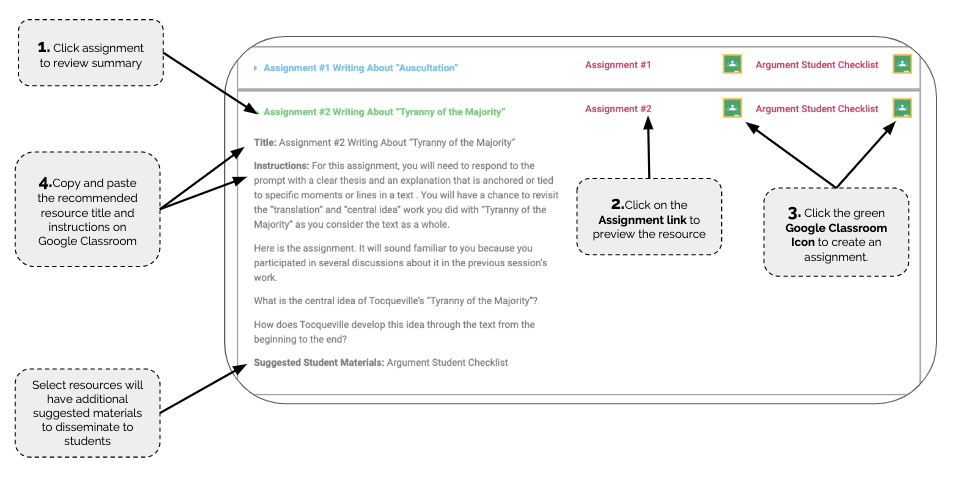Faces of the Essay: An Orientation to the Form - Grade 8
This unit is built around a small collection of essays. A large portion of the work is devoted to reading and re-reading these texts using a few questions to guide the readings and to focus the discussions and other work that follows. The object, then, is to work carefully with a small set of texts in order to make some first-hand discoveries about the nature of informative/explanatory texts: What they can look like, what they can do, and how they are similar and different.


Table of Contents
Writing Tasks
Title: Understanding Essays: A Protocol for Working with Texts
Teacher Manual Instructions:
Session 1-4
The “Understanding Essays” protocol is a general template designed for work with essays of all shapes and kinds. The order of the work on the protocol—considering the arguments in the essay before considering what is compelling in the essay— is intentional. The arguments of an essay must be studied first. If not, we run the risk of glossing over, or missing altogether, the heart of the texts under consideration.
Title: The Essay: Ideas to Consider
Teacher Manual Instructions:
Session 6
Display a copy of “The Essay: Ideas to Consider” for the class to see and dis- tribute copies to students. (A copy-ready version can be found in Appendix B.)
Review the “Ideas” sheet with the class.
To ensure that students better comprehend the gist of sheet, take a minute to draw an example of the “Characteristics of the Author’s Presence” continuum on a piece of chart paper, with the heading “Personal” at the far left end and “Transpersonal” at the far right end.
Tell students that during the next few sessions, the class will take on the challenge of arranging the five model essay texts on this continuum.
Remind the class that there is no single definitive spectrum; the value of this exercise is in the work itself—the conversations, the arguments made and considered, and the careful readings required by it.
Title: The Essay Writing Project
Teacher Manual Instructions:
Session 15-16
Review the assignment with the class and answer any questions students have about the assignment. Be sure to remind students that ideas for their essays may already exist in their writing notebooks and folders in the form of drafts, notes, or quick writes.
Take some additional time to clarify the reasons for writing two essays about the same topic. Ask the class to think with you about what this “side-by- side” work might help students come to better understand.
Title: Essay Commentary
Teacher Manual Instructions:
Session 29
Review the “Essay Commentary” form with the class.
Take time to illustrate portions of it and to answer any questions students have about completing it. Remind students that they must attach a completed “Essay Commentary” form to each of their two essays when they turn them in.
Title: Faces of the Essay: Self-Assessment
Teacher Manual Instructions:
Session 30
Focus Lesson
Walk students through the categories and questions.
Answer any questions students have about the self-assessment.
Work Period
- Give students the work period to complete the self-assessment.
Charts for Discussion
Title: Characteristics of the Author’s Presence
Teacher Manual Instructions:
Session 6
To ensure that students better comprehend the gist of sheet, take a minute to draw an example of the “Characteristics of the Author’s Presence” continuum on a piece of chart paper, with the heading “Personal” at the far left end and “Transpersonal” at the far right end.
Tell students that during the next few sessions, the class will take on the challenge of arranging the five model essay texts on this continuum.
Remind the class that there is no single definitive spectrum; the value of this exercise is in the work itself—the conversations, the arguments made and considered, and the careful readings required by it.
Title: Signs of Author’s Presence
Teacher Manual Instructions:
Session 7
Review the notion of the “author’s presence” with the class. Remind the class that the author is always present, but present in different ways—through her argument or position, the personal stories she tells, or in the way materials are selected and arranged. The author is always there, selecting this over that, putting it this way rather than that way, taking this perspective rather than another.
Using display copies of the essays, work with the class to underline, circle, or otherwise identify exact words, lines, and/or sections in each essay that signal the presence of the author. For example, you might circle the word “I” or underline a phrase such as “Twenty minutes from my house . . .” You might underline a paragraph that contains details describing a place (that these particular details were selected and others left out is yet another example of author’s presence). Add excerpts or summaries of these examples to a two-column chart titled “Signs of Author’s Presence.” Place the examples in one column.
Collaborate with the class to come up with descriptors of the ways authors reveal (or conceal) themselves in essays. Place these in the second column of the chart. Be slow to “give away” items that students might otherwise discover in the work period discussions.
Checks for Understanding
Title: Characteristics of a Good Small-Group Partner
Teacher Manual Instructions:
Session 5
Explain to the class that before Session 9 each student will be expected to locate and bring to class three copies of one essay. During Sessions 9-12, students will apply the “Understanding Essays” protocol to these essays as well. At the end of that work, groups will be required to make brief presentations about their work to the rest of the class. Students will have a few days to locate an essay while the class works on the essay continuum task.
Collaborate with the class to create a chart titled “Characteristics of a Good Small-Group Partner.” Your chart should include items that address behavior, attitude, effort, and the habits of effective talk.
Once you have completed the chart to your satisfaction, ask students to think for a moment about one or two other students who fit the chart criteria. Ask them to list these names on a piece of paper. Collect these and use the information to plan groups for the upcoming “reading essays” work.
Title: Small-Group Work: Problems and Solutions
Teacher Manual Instructions:
Session 9-11
Closing Meeting
Reconvene the class and take time to debrief the reading essays work of the session. What was challenging? What went well? What will you do to prepare for the next session? How will the group use that session’s work period?
Consider creating a chart titled, “Small-Group Work: Problems and Solutions.” Divide it into two columns—“Problems” and “Solutions.” Ask volunteers to offer short descriptions of problems that arose during this time.
After you have a list of problems, ask the class to help you brainstorm possible solutions for each problem listed.
Title: Good Presentations
Teacher Manual Instructions:
Session 13-14
Ask the class what made for a good presentation today?
Track students’ thinking on a chart titled “Good Presentations.”
Title: What Did You Learn in This Unit?
Teacher Manual Instructions:
Session 29
Ask the class: “What did you learn in this unit?”
Capture student responses on a chart or another display.
Independent Reading
Title: Reading Log
Teacher Manual Instructions:
Independent Reading
As you transition to independent reading, discuss how students can keep a reading log. Show students how you would like them to set up and use their reading log to record their independent reading this year. An example of one way a reading log could be set up is provided nearby. You may choose to have students create a table in their notebooks, use a pre-made sheet, or a digital format.
Explain to students that they should make an entry in their log only after they have finished a book. You will need to negotiate with students how to handle the entry of magazine readings (for example, entire issues versus individual articles).
After students have set up the log, including proper headings, creating the grid, etc., show students how to make an entry.
Answer any questions students have about the reading log.
Begin independent reading.
Consider conducting individual reading conferences with students as they are engaged in independent reading. In No More Independent Reading Without Support, Debbie Miller and Barbara Moss (2013) suggest that during early conferences, you should listen to students and work to build trust: Ask students how they view reading and how they think of themselves as readers; ask what they are interested in. Over time you can ask more about what they are reading and about how you can help them or what they are struggling with. Use what you learn from these conversations to guide additional instruction with groups or with the class.
Title: Independent Reading – Individual Planning Sheet
Instructions:
Title: End of Marking Period Self-Assessment
Instructions:
Unit Resources
Title: Understanding Essays: A Protocol for Working with Texts
Title: Scaffolds and Modifications: Descriptions and Use
